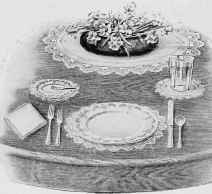How To Cook Meats. Part 2
Description
This section is from the book "The Institute Cook Book", by Helen Cramp. Also available from Amazon: The Institute Cook Book.
How To Cook Meats. Part 2
Roasting
The chief point to remember in roasting is that the meat should be quickly browned in order that the crust thus formed may retain the juices. The oven should therefore be hot when the meat is put in and the heat, if possible, gradually reduced.
Wipe the meat with a damp cloth, but do not wash it. Sprinkle with pepper and salt and just a little flour, and put in a pan with a small piece of fat or drippings. When the meat is seared, add a little water and baste every ten minutes. When one side is thoroughly browned, turn over and brown the other side. When done, remove the roast; pour off almost all of the fat and make a brown sauce according to the directions in the chapter on "Sauces."
If the meat is very lean it is a good plan to lay thin slices of fat meat, bacon or pork over the top.
Broiling
The object of boiling is to coagulate as quickly as possible all the albumen on the surface of the meat, sealing up the pores so that none of the juices may escape. It is therefore a good plan to warm the gridiron before putting on the meat so that none of the heat may be conducted away. The broiling should be done over a Family of Four a clear fire at least two inches away from the gridiron. Meat cooked by this method is more wholesome than meat cooked in any other way; but if the fire is not hot, most of the juices will be lost. Season with salt, pepper and butter when the meat is done; do not season before cooking, as salt draws out the juices.
Pan-broiling is less desirable than broiling over hot coals, though when properly done the meat has much the same flavor and appearance. Have the pan red hot and if the meat is very lean, rub the pan with fat; but do not leave any fat in the pan. Sear the meat quickly on one side, then on the other; then cook, turning several times, Season and serve.
Boiling
Boiling is one of the easiest methods of cooking meat, but it is not satisfactory unless the proper method is followed. In making soup the meat is put in cold water to draw out the juices; in boiling it should be put in hot water, so that the meat and not the water may retain the juices and flavoring. Some of them will necessarily escape, but the boiling water coagulates the albumen on the surface of the meat, forming a sort of coat.
Salt meat should be soaked in cold water before boiling, but frssh meat should simply be wiped with a damp cloth. Have the kettle scrupulously clean; put in it enough water to cover the meat and when boiling drop in the meat. Boil hard for five minutes; then draw the kettle aside and let the meat cook slowly Cover closely and remove all scum that rises.
Frying
Frying is cooking in very hot fat, and the secret of success is to have the fat hot enough to harden the outer surface of the meat immediately and deep enough to cover the meat. As the fat can be saved and used many times, the use of a large quantity is not extravagant.
Have a frying pan with a wire basket and arrange the pieces of meat or croquettes so that they will not touch each other. Plunge them in the fat, testing it first with a small piece of bread, which should brown in thirty seconds. When cooked, drain the meat over the hot fat; shake the basket and place the pieces on soft paper so that the fat may be absorbed.
Olive oil is best for frying; but as it is expensive for general use, various compounds such as cottolene, suetine, crisco, etc., may be used. These on the whole are better than lard, which is easily absorbed and therefore apt to make the food greasy. Suet and drippings are cheapest; but suet alone cools quickly and leaves a tallowy taste.

For a Breakfast

For a Luncheon

For a Formal Dinner
Continue to:


